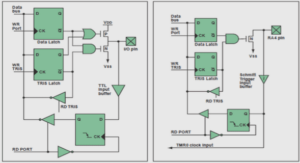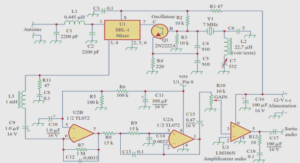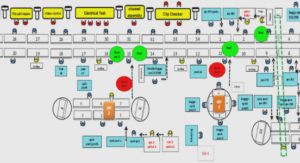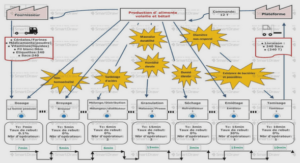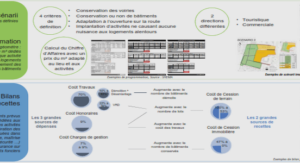Optimal Design Problem Formulation
Design Objective
Design of Vehicle Propulsion Systems (VPSs) is confronted with high complexities due to powertrain technology (conventional, battery-electric, or hybrid-electric vehicles), powertrain architecture (in particular, series, parallel, and power-split architecture for HEVs), powertrain component (mechanical and electrical ones, such as internal combustion engine, transmission, battery, electric motor/generator), powertrain control (powertrain control optimization for the minimal energy consumption in HEVs). Meanwhile new vehicle product offerings must concurrently response to meet customer wants and regulatory requirements. To cope with these complexities, the optimal design technique is highly requested to achieve the desired requirements, for instance, lower energy consumption. Throughout this thesis, the objective of the optimal design problem for vehicle propulsion systems is solely to minimize the energy consumption by finding the best dimensioning parameters of powertrain components, which yields min d∈Sadm L(d), (7.1) s.t. gi (d) ≤ 0, for each i ∈ {1,. . . ,m}, hj (d) = 0, for each j ∈ {1,. . . ,n}, (7.3) where d presents generic dimensioning parameters to optimize that is defined by d ∈ n S : Se ∪ Sd ∪ Sb ∪ Sm ∪ Sg o , Sadm is the admissible design space that is constrained by desired requirements, L(d) represents the energy consumption, and gi (d) and hj (d) indicate generic equality and in-equality constraints. In particular, the objective function L(d) depends on powertrain technologies. Considering a conventional vehicle, the design objective function is L(d) = Z tf t0 Pef (t, d) dt; (7.4) whereas, the objective function for battery-electric vehicles is L(d) = Z tf t0 Pbe(t, d) dt. (7.5) The objective function of hybrid-electric vehicles is more complex than that of singlesource ones because of the inevitability of control optimization for the evaluation of the minimal energy consumption. Thus, the objective function of the optimal design is L(d) = Z tf t0 Pef (u(t), t, d) dt.
Design Constraint
Constraints of the optimal design for vehicle propulsion systems are introduced and partially determined by the parameters of vehicle attributes, such as top speed, acceleration, and gradeability. Simple analytic models are developed to evaluate the design constraints based on the required vehicle attributes.
Vehicle Attribute
The considered constraints in the design problem of vehicle propulsion systems mainly consist of vehicle performance parameters, which are known as vehicle attributes. Despite comprehensive vehicle attributes discussed in [27], the most interesting ones are composed of vehicle top parameters, all-electric range D is of high interest, particularly for plug-in hybridelectric and battery-electric vehicles. Top Speed As a frequent mentioned vehicle attribute of light-duty vehicles, the top speed (denoted by vtop) is defined as a constant cruising speed that is determined by the available power and the resistance on a flat road. The tractive effort is further simplified, because the energy consumption of the rolling friction is typically one order of magnitude smaller than the aerodynamic friction consumed power at vehicle top speed. Thus, the approximation of the maximum traction power for passenger cars is written as Pi,v ≈ ρarCarAarv 3 top 2 , (i = e,m), (7.7) where e indicates internal combustion engine in a conventional or hybrid-electric vehicle, whereas m refers to electric motor in a battery-electric or plug-in hybrid-electric vehicle. Gradeability Gradeability is a relevant metric for both light- and heavy-duty vehicles. It is defined as the grade which a vehicle can overcome at a certain speed. The approximated tractive effort of a vehicle climbing an uphill road with a slope α without accounting for powertrain efficiency is Ti,α = mvgCrr cosα + mvg sinα + 0.5ρarCarAarv 2 v Rw Rd , (i = e,m), (7.8) where Rd is the dimensioning parameter of a drivetrain. Correspondingly, the further simplified estimation of the maximum tractive power is Pi,α ≈ mvgv(sinα +Crr cosα), (i = e,m). (7.9) In addition to the gradeability, a similar performance parameter, i.e. startability, is considered as well for both light- and heavy-duty vehicles [74]. The startability is only considered when a vehicle starts movement from standstill. Note that, the full load of vehicle is applied in both gradeability and startability estimation. speed vtop, gradeability of start-up αls and of high speed αhs, and standstill acceleration time from 0 to 100 km/h t100.
Acceleration Performance
The acceleration performance is usually described by the accelerating time from standstill to 100 km/h or to 60 mph and the distance covered from zero speed to a certain speed on level road. Using Newton’s second law, the acceleration time t100 obtained from the maximum tractive effort is evaluated by t100 = Z 100/3.6 0 mv TiRd /Rw − mvgCrr − 0.5ρarCarAarv 2 dv. (7.10) The acceleration time from standstill to 100 km/h is not only valid for engine-based and hybrid-electric vehicles, but for some powerful battery-electric vehicles as well. Moreover, the acceleration time t100 is not able to compute directly due to the highly dynamic effects. A further simplified model between acceleration time and the maximal power of the main tractive powertrain component (such as internal combustion engine or electric motor/generator) is expressed as t100 = ct100 mvv 2 100 Pi,t , (i = e,m), (7.11) where ct100 = 0.877 for diesel engine vehicles, ct100 = 0.929 for gasoline engine vehicles, and ct100 = 0.767 for battery-electric vehicles. A simple yet direct verification of the acceleration time model in Eq. 7.11 is demonstrated in Fig. 7.1 for conventional vehicles. The published acceleration time is denoted by t100, whereas the estimated acceleration time is indicated by t p 100. The estimated acceleration time agreed with the published one.
Design Space
Design space is the admissible range of dimensioning parameters resulting from the design constraints. Vehicle attribute significantly affects the rated power and rated torque of the power sources, such as internal combustion engine, electric motor/generator. As a consequence, the rated power of internal combustion engine or electric motor/- generator in different vehicle applications must satisfy Pi ≥ max{Pi,v,Pi,α,Pi,t}, (i = e,m). (7.13) As for the rated torque of an internal combustion engine or electric motor/generator, it is expressed as Ti ≥ Ti,α, (i = e,m). (7.14) In regard to the desired all-electric range, the minimal applicable energy of a battery is constrained as Eb ≥ Eb , (7.15) where E is the applicable energy of battery to size. Additionally, implicit constraints on the dimensioning parameters of powertrain components are taken into account. For instance, battery must be capable of providing sufficient electrical power to electric motor/generator during vehicle operation. Considering an internal combustion engine, its rated torque is not independent from its displacement, which yields Te = cetVe , (7.16) where the coefficient cet is 148.63 Nm/L for CI/TC engines, 161.81 Nm/L for SI/TC engines, and 93.44 Nm/L for SI/NA engines. Furthermore, its torque of the rated power is linearly modeled as a function of engine displacement, which is given by Tep = cepVe , (7.17) where the coefficient cep is 116.34 Nm/L for CI/TC engines, 136.80 Nm/L for SI/TC engines, and 85.63 Nm/L for SI/NA engines. Coefficients in Eq. 7.16 and 7.17 are further validated with the light-duty engines in Table 2.4. Fig. 7.3a, 7.4a, and 7.5a illustrate the comparison of the rated torque and the estimated one for engines in terms of SI/TC, SI/NA, and CI/TC, respectively; whereas the comparison of the torque of rated power is correspondingly depicted in Fig. 7.3b to 7.5b.

